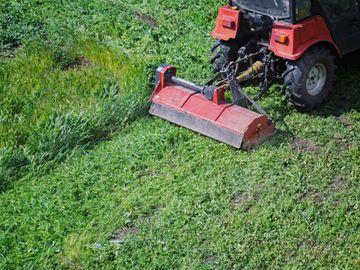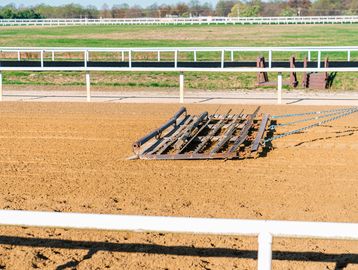Our Services

Flail Mowing
Flail mowing keeps grass, weeds, and rough areas under control. Using a quad-towed mower, it can manage long or thick growth where traditional mowing struggles.
Why do we do flail mowing?
Because unmanaged weeds and long grass reduce grazing quality, spread weeds further, and make pastures less safe for animals. Regular mowing encourages healthier, thicker grass.

Harrowing
Pasture harrowing breaks up dung, moss, and thatch while spreading organic matter evenly across the field. It also helps aerate the soil.
Why do we do harrowing?
Because it boosts grass recovery, helps control parasites by breaking up droppings, and improves soil-to-seed contact if reseeding is planned.

Rolling
Rolling levels hoof marks, ruts, and poached ground, leaving a firmer, safer surface.
Why do we do rolling?
Because level ground prevents injuries to horses, improves grass regrowth, and creates a tidy finish for paddocks or event areas.

Spraying
We use ATV boom sprayers or lances to target broadleaf weeds such as docks, nettles, thistles, and buttercups or the total area.
Why do we do spraying?
Because weeds compete with grass for nutrients, reduce grazing quality, and in some cases (like ragwort) can be dangerous to livestock.

Weed Wiping
A contact applicator wipes herbicide directly onto taller weeds without harming the surrounding grass.
Why do we do weed wiping?
Because it’s a safe and efficient way to target weeds in mixed swards where you don’t want to spray the whole pasture.

Overseeding
Spreading new grass seed onto tired or thin pastures to restore growth and improve grazing.
Why do we do overseeding?
Because fields lose productivity over time — overseeding thickens the sward, improves forage quality, and reduces the space for weeds to establish.

Slug Pelleting
Pellet applicators spread evenly across crops or grassland to prevent slug damage.
Why do we do slug pelleting?
Because slugs cause major losses in young crops and reseeded fields — pelleting protects your investment and ensures better establishment.

Path/ Track Maintenance
Grading and levelling of farm tracks, gateways, and yards to improve usability and reduce puddling and mud.
Why do we do track maintenance?
Because poor tracks damage vehicles, stress livestock, and create mud problems. A well-maintained track saves time and hassle year-round.

Brush and Debris Clearance
We cut back brambles, scrub, and unwanted growth to tidy fields, hedges, and boundaries.
Why do we do clearance?
Because unmanaged scrub takes over useful grazing areas and makes land harder to maintain. Clearing restores usable ground.

Winter Gritting & Snow Management
Application of salt and grit to roads, car parks, and yards, plus snow clearance if needed.
Why do we do gritting?
Because safety matters — icy surfaces put staff, customers, and animals at risk. Regular gritting prevents accidents and disruption.
Add a footnote if this applies to your business